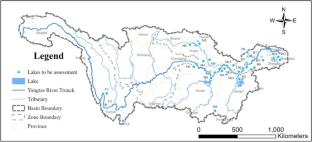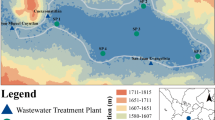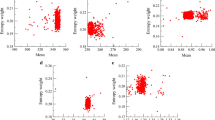Abstract
The precise assessment of a water body’s eutrophication status is essential for making informed decisions in water environment management. However, conventional approaches frequently fail to consider the randomness, fuzziness, and inherent hidden information of water quality indicators. These would result in an unreliable assessment. An enhanced method was proposed for the eutrophication assessment under uncertainty in this study. The multi-dimension gaussian cloud distribution was introduced to capture the randomness and fuzziness. The Shannon entropy based on various sample size and trophic levels was proposed to maximize valuable information hidden in the datasets. Twenty-seven significant lakes and reservoirs located in the Yangtze River Basin were selected to demonstrate the proposed method. The sensitivity and consistency were used to evaluate the accuracy of the proposed method. Results indicate that the proposed method has the capability to effectively assess the eutrophication status of lakes and reservoirs under uncertainty and that it has a better sensitivity since it can identify more than 33–50% trophic levels compared to the traditional methods. Further scenario experiments analysis revealed that the sample information richness, i.e., sample size and the number of trophic levels is of great significance to the accuracy/robustness of the method. Moreover, a sample size of 60 can offer the most favorable balance between accuracy/robustness and the monitoring expenses. These findings are crucial to optimizing the eutrophication assessment.










Similar content being viewed by others
Data Availability
Data that support the findings of this study will be made available from the corresponding author on reasonable request.
References
Adun H (2023) Sustainability energy security: 20 years assessment of the West African Nations using a comprehensive entropy-TOPSIS analysis. Environ Sci Pollut Res 30:81093–81112
Afrane S, Ampah JD, Jin C, Liu H, Aboagye EM (2021) Techno-economic feasibility of waste-to-energy technologies for investment in Ghana: a multicriteria assessment based on fuzzy TOPSIS approach. J Clean Prod 318:128515
Andersen JH, Carstensen J, Conley DJ, Dromph K, Fleming-Lehtinen V, Gustafsson BG, Josefson AB, Norkko A, Villnas A, Murray C (2017) Long-term temporal and spatial trends in eutrophication status of the Baltic Sea. Biol Rev 92:135–149
Baty F, Ritz C, Charles S, Brutsche M, Flandrois JP, Delignette-Muller ML (2015) A toolbox for nonlinear regression in R: the package nlstools. J Stat Softw 66:1–21
Cassidy R, Doody DG, Watson CJ (2017) Impact of legacy soil phosphorus on losses in drainage and overland flow from grazed grassland soils. Sci Total Environ 575:474–484
Chen ZY, Li JF, Shen HT, Wang ZH (2001) Yangtze River of China: historical analysis of discharge variability and sediment flux. Geomorphology 41:77–91
Chen Y, Zhu L, Zhou R (2007) Characterization and distribution of polycyclic aromatic hydrocarbon in surface water and sediment from Qiantang River, China. J Hazard Mater 141:148–155
Chen X, Wang Y, Sun T, Chen Y, Zhang M, Ye C (2022) Evaluation and prediction of water quality in the dammed estuaries and rivers of Taihu Lake. Environ Sci Pollut Res 29:12832–12844
Chen Q, Huang MT, Tang X (2020) Eutrophication assessment of seasonal urban lakes in China Yangtze River Basin using Landsat 8-derived Forel-Ule index: a six-year (2013-2018) observation. Sci Total Environ 745:135392
Deng W, Wang G (2017) A novel water quality data analysis framework based on time-series data mining. J Environ Manag 196:365–375
Ding Y, Zhao J, Peng W, Zhang J, Chen Q, Fu, Y, Duan M (2021) Stochastic trophic level index model: a new method for evaluating eutrophication state. J Environ Manag 280:111826
Du YB, Zheng YS, Wu GA, Tang Y (2020) Decision-making method of heavy-duty machine tool remanufacturing based on AHP-entropy weight and extension theory. J Clean Prod 252:119607
Feng L, Cheng Y, Zhang Y, Li Z, Yu Y, Feng L, Zhang S, Xu L (2020) Distribution and human health risk assessment of antibiotic residues in large-scale drinking water sources in Chongqing area of the Yangtze River. Environ Res 185:109386
Ferreira JG, Andersen JH, Borja A, Bricker SB, Camp J, da Silva MC, Garces E, Heiskanen A-S, Humborg C, Ignatiades L, Lancelot C, Menesguen A, Tett P, Hoepffner N, Claussen U (2011) Overview of eutrophication indicators to assess environmental status within the European Marine Strategy Framework Directive. Estuar Coast Shelf Sci 93:117–131
Garcia Nieto PJ, Garcia-Gonzalo E, Alonso Fernandez JR, Diaz Muinz C (2019) Water eutrophication assessment relied on various machine learning techniques: a case study in the Englishmen Lake (Northern Spain). Ecol Model 404:91–102
Gilbert PM (2017) Eutrophication, harmful algae and biodiversity - challenging paradigms in a world of complex nutrient changes. Mar Pollut Bull 124:591–606
Guan Q, Feng L, Hou X, Schurgers G, Zheng Y, Tang J (2020) Eutrophication changes in fifty large lakes on the Yangtze Plain of China derived from MERIS and OLCI observations. Remote Sens Environ 246:111890
Han X, Tang F, Liu AL (2024) Drinking water quality evaluation in supply systems in Wuhan, China: application of entropy weight water quality index and multivariate statistical analysis. Environ Sci Pollut R 31:445–457
Hou XJ, Feng L, Dai YH, Hu CAM, Gibson L, Tang J, Lee ZP, Wang Y, Cai XB, Liu JG, Zheng Y, Zheng CM (2022) Global mapping reveals increase in lacustrine algal blooms over the past decade. Nat Geosci 15:130–134
Huang JC, Zhang YJ, Arhonditsis GB, Gao JF, Chen QW, Peng J (2020) The magnitude and drivers of harmful algal blooms in China’s lakes and reservoirs: A national-scale characterization. Water Res 181:115902
Lai CW, Ma Z, Liu ZH, Sun HL, Yu QC, Xia F, He XJ, Bao Q, Han YQ, Liu X, He HB (2023) Alleviating eutrophication by reducing the abundance of Cyanophyta due to dissolved inorganic carbon fertilization: insights from Erhai Lake, China. J Environ Sci 131:68–83
Lai RY, Chen XH, Zhang LL (2022) Evaluating the impacts of small cascade hydropower from a perspective of stream health that integrates eco-environmental and hydrological values. J Environ Manag 305:114366
Li D, Du Y (2008) Artificial intelligence with uncertainty. Chapman and Hall/CRC, Boca Raton
Li X, ZK, Gu P, et al (2021) Changes in precipitation extremes in the Yangtze River Basin during 1960–2019 and the ssociation with global warming, ENSO, and local effects. Sci Total Environ 760:144244
Li LX, Liang TJ, Qiu S, Zhang YL, Qu JW, Liu TT, Ma F (2023) A rapid and simplified method for evaluating the performance of fungi-algae pellets: a hierarchical analysis model. Sci Total Environ 860:160442
Lin SS, Shen SL, Zhou AN, Xu YS (2020) Approach based on TOPSIS and Monte Carlo simulation methods to evaluate lake eutrophication levels. Water Res 187:116437
Lin SS, Shen SL, Zhou AN, Lyu HM (2021) Assessment andmanagement of lake eutrophication: a case study in Lake Erhai, China. Sci Total Environ 751:141618
Liu XC, Beusen AHW, Van Beek LPH, Mogollon JM, Ran XB, Bouwman AF (2018) Exploring spatiotemporal changes of the Yangtze River (Changjiang) nitrogen and phosphorus sources, retention and export to the East China Sea and Yellow Sea. Water Res 142:246–255
Liu YX, Ke YH, Wu H, Zhang CL, Chen XW (2023) A satellite-based hybrid model for trophic state evaluation in inland waters across China. Environ Res 225:115509
Luthra S, Govindan K, Kannan D, Mangla SK, Garg CP (2017) An integrated framework for sustainable supplier selection and evaluation in supply chains. J Clean Prod 140:1686–1698
Ma JG, He F, Qi TC, Sun Z, Shen M, Cao ZG, Meng D, Duan HT, Luo JH (2022) Thirty-four-year record (1987-2021) of the spatiotemporal dynamics of algal blooms in Lake Dianchi from multi-source remote sensing insights. Remote Sens 14:4000
McDonald CP, Lottig NR, Stoddard JL, Herlihy AT, Lehmann S, Paulsen SG, Peck DV, Pollard AI, Stevenson RJ (2014) Comment on Bachmann et al. (2013): a nonrepresentative sample cannot describe the extent of cultural eutrophication of natural lakes in the United States. Limnol Oceanogr 59:2226–2230
Peng T, Deng HW, Lin Y, Jin ZY (2021) Assessment on water resources carrying capacity in karst areas by using an innovative DPESBRM concept model and cloud model. Sci Total Environ 767:144353
Qi WX, Wang X, Kang J, Bai YH, Bian R, Xue HT, Chen L, Guan AM, Pan YR, Liu HJ, Qu JH (2023) Improvement of the Yangtze Rivers? Water quality with substantial implementation of wastewater services infrastructure since 2013. Engineering 21:135–142
Qin BQ, Zhou J, Elser JJ, Gardner WS, Deng JM, Brookes JD (2020) Water depth underpins the relative roles and fates of nitrogen and phosphorus in lakes. Environ Sci Tech 54:3191–3198
Ruan DM, Bian JM, Wang Q, Wu JJ, Yu YX, Gu ZQ (2021) Application of modified cloud model-level eigenvalue method in water quality evaluation. J Hydrol 603:126980
Scavia D, Allan JD, Arend KK, Bartell S, Beletsky D, Bosch NS, Brandt SB, Briland RD, Daloglu I, DePinto JV, Dolan DM, Evans MA, Farmer TM, Goto D, Han HJ, Hook TO, Knight R, Ludsin SA, Mason D, Michalak AM, Richards RP, Roberts JJ, Rucinski DK, Rutherford E, Schwab DJ, Sesterhenn TM, Zhang HY, Zhou YT (2014) Assessing and addressing the re-eutrophication of Lake Erie: central basin hypoxia. J Great Lakes Res 40:226–246
Tang XQ, Li R, Han D, Scholz M (2020) Response of eutrophication development to variations in nutrients and hydrological regime: a case study in the Changjiang River (Yangtze) Basin. Water 12:1634
Tong YD, Zhao Y, Zhen GC, Chi J, Liu XH, Lu YR, Wang XJ, Yao RH, Chen JY, Zhang W (2015) Nutrient loads flowing into coastal waters from the main rivers of China (2006-2012). Sci Rep 5:16678
Tong YD, Zhang W, Wang XJ, Couture RM, Larssen T, Zhao Y, Li J, Liang HJ, Liu XY, Bu XG, He W, Zhang QG, Lin Y (2017) Decline in Chinese lake phosphorus concentration accompanied by shift in sources since 2006. Nat Geosci 10:507–511
Wang D, Liu D, Ding H, Singh VP, Wang Y, Zeng X, Wu J, Wang L (2016a) A cloud model-based approach for water quality assessment. Environ Res 148:24–35
Wang D, Zeng D, Singh VP, Xu P, Liu D, Wang Y, Zeng X, Wu J, Wang L (2016b) A multidimension cloud model-based approach for water quality assessment. Environ Res 149:113–121
Wang JL, Fu ZS, Qiao HX, Liu FX (2019) Assessment of eutrophication and water quality in the estuarine area of Lake Wuli, Lake Taihu, China. Sci Total Environ 650:1392–1402
Wang XC, Ma HQ, Li RH, Song ZS, Wu JP (2012) Seasonal fluxes and source variation of organic carbon transported by two major Chinese Rivers: the Yellow River and Changjiang (Yangtze) River. Global Biogeochem Cy 26:GB2025
Wang YM, Zhang XE, Wu YF (2020a) Eutrophication assessment based on the cloud matter element model. Int J Environ Res Public Health 17:331–334
Wang YH, Wen ZG, Li HF (2020b) Symbiotic technology assessment in iron and steel industry based on entropy TOPSIS method. J Clean Prod 260:120900
Wu D, Yan H, Shang M, Shan K, Wang G (2017) Water eutrophication evaluation based on semi-supervised classification: a case study in Three Gorges Reservoir. Ecol Indic 81:362–372
Xie T, Wang MI, Su C, Chen WP (2020) Evaluation of the natural attenuation capacity of urban residential soils with ecosystem-service performance index (EPX) and entropy weight methods. Environ Pollut 265:222–229
Xu HS, Ma C, Lian JJ, Xu K, Chaima E (2018) Urban flooding risk assessment based on an integrated k-means cluster algorithm and improved entropy weight method in the region of Haikou, China. J Hydrol 563:975–986
Yan H, Wu D, Huang Y, Wang G, Shang M, Xu J, Shi X, Shan K, Zhou B, Zhao Y (2017) Water eutrophication assessment based on rough set and multidimensional cloud model. Chemometr Intell Lab Systems 164:103–112
Yan DD, Wunnemann B, Jiang ZL (2020) Hydrological variations of a lake-catchment and human interaction during the last 6 ka in Yunnan, China. J Hydrol 587:124932
Yang W, Xu K, Lian J, Ma C, Bin L (2018) Integrated flood vulnerability assessment approach based on TOPSIS and Shannon entropy methods. Ecol Indic 89:269–280
Yang Z, Wang YF (2020) The cloud model based stochastic multi-criteria decision making technology for river health assessment under multiple uncertainties. J Hydrol 581:124437
Yao JP, Wang GQ, Xue BL, Wang PZ, Hao FH, Xie G, Peng YB (2019) Assessment of lake eutrophication using a novel multidimensional similarity cloud model. J Environ Manag 248:109259
Yao JP, Wang GQ, Wang LB, Zhang XJ, Wang PZ (2021) Assessing the spatiotemporal variability of lake water quality using A novel multidimensional shape - position similarity cloud model. J Hydrol 599:126379
Zang N, Zhu J, Wang X, Liao YJ, Cao GZ, Li CH, Liu Q, Yang ZF (2022) Eutrophication risk assessment considering joint effects of water quality and water quantity for a receiving reservoir in the South-to-North Water Transfer Project, China. J Clean Prod 331:129966
Zhang SH, Xiang MS, Xu Z, Wang L, Zhang C (2020) Evaluation of water cycle health status based on a cloud model. J Clean Prod 245:118850
Zou ZH, Yun Y, Sun JN (2006) Entropy method for determination of weight of evaluating indicators in fuzzy synthetic evaluation for water quality assessment. J Environ 18:1020–1023
Funding
This work was supported by the National Natural Science Foundation of China (52300244) and the Major Project of the National Social Science Foundation of China (21&ZD166).
Author information
Authors and Affiliations
Contributions
Nan Zang: conceptualization, methodology, formal analysis, data curation, writing—original draft, writing—review and editing, visualization, software, validation, investigation. Guozhi Cao: resources, writing—review and editing. Yanxue Xu: investigation, visualization, resources. Yu Feng: investigation. Zesheng Xu: investigation. Xiafei Zhou: investigation. Jiaxun Guo: investigation, visualization. Yunjie Liao: conceptualization, methodology, formal analysis, writing—original draft, writing—review and editing, visualization, validation, supervision.
Corresponding author
Ethics declarations
Ethical approval
Not applicable.
Consent to participate
Not applicable.
Consent to publish
The authors confirm that they have obtained written consent from each participant to publish the manuscript.
Competing interests
The authors declare no competing interests.
Additional information
Responsible Editor: Marcus Schulz
Publisher's Note
Springer Nature remains neutral with regard to jurisdictional claims in published maps and institutional affiliations.
Supplementary Information
Below is the link to the electronic supplementary material.
Rights and permissions
Springer Nature or its licensor (e.g. a society or other partner) holds exclusive rights to this article under a publishing agreement with the author(s) or other rightsholder(s); author self-archiving of the accepted manuscript version of this article is solely governed by the terms of such publishing agreement and applicable law.
About this article
Cite this article
Zang, N., Cao, G., Xu, Y. et al. An innovative method based on Gaussian cloud distribution and sample information richness for eutrophication assessment of Yangtze’s lakes and reservoirs under uncertainty. Environ Sci Pollut Res (2024). https://doi.org/10.1007/s11356-024-33307-9
Received:
Accepted:
Published:
DOI: https://doi.org/10.1007/s11356-024-33307-9




